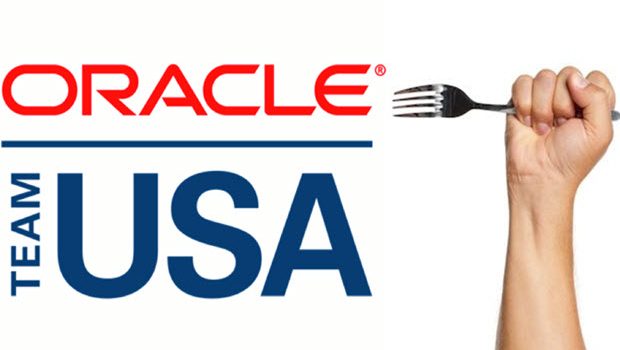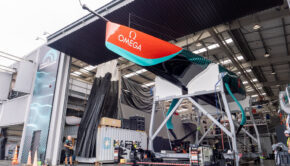America’s Cup: Stick a fork in it
Published on June 19th, 2017
Like a weekly television program, we watched the first episode of the 35th America’s Cup last weekend. In that show, Emirates Team New Zealand had the starring role, got the good camera angles, and all the best lines. Will Oracle Team USA have a bigger part in the next episode? Matthew Sheahan, Producer of The World Sailing Show, offers some insight from Bermuda.
So why are the Kiwis challengers so fast and is there anything Oracle can do to come back?
No doubt I’ll be eating my words when they return to the course on June 24, but for now I’d say that it’s going to be very difficult indeed for the Defenders to find sufficient pace to out run the Kiwis.
There’s been plenty of attention on the Kiwi bicycles providing heaps of power, but I don’t think that’s where the advantage lies.
The issue is more with Team New Zealand’s control system – this is at the heart of their campaign.
Over the last couple of weeks we have discovered two things that stand out.
First, that their flight control system is seriously impressive.
Unlike the other teams, theirs tells their crew members what settings they should be on at any given point. Like an autopilot that tells you what you should do, but stops short of doing it for you, their control systems give guidance to those in trimming roles such as Blair Tuke on the foils and Glenn Ashby on the wing.
Out here we’re calling it chasing the dots. I have no idea whether this is really the case but the analogy is that the computer shows you where you should be, you just match it.
The second impressive feature is that this is only possible because the Kiwi crew have their hands free thanks to their bikes.
The focus so far has been on the power output, but the reality seems to be that while they may be able to squeeze a few more watts out of the pedal based system, being able to control other items by hand is the key.
So when you’ve got a sophisticated control system and reliable human inputs you get stable flight. And when you’ve got stable flight you can perform tricky manoeuvres such as a last minute tack or gybe in a heartbeat.
But you can also push the design envelope.
For example, the Kiwis’ cranked foils need to be flown more accurately because they have less vertical shaft. Ride too high and they run out of side force early as the boat rises up. But if you can control the ride height precisely you can create far more efficient foils. And it is clear that the Kiwis have these.
A similar design loop exists with the wing.
Most of the teams have been controlling the power in the rig with the wing sheet in the same way that you and I would play the mainsheet.
But the Kiwis have effectively cleated the mainsheet and are controlling the power by altering the twist. The equivalent of trimming the kicker.
Doing this keeps the power low down even when they are spilling out the top of the sail to de-power the rig.
Again, this is probably only possible because of the accurate flight control system and a sophisticated algorithm that tells wing trimmer Glenn Ashby how to trim the wing at any given moment.
With the crew chasing dots to sail as efficiently as possible, perhaps it’s hardly surprising that we are not hearing much chatter on board Emirates Team New Zealand.
On Oracle the dialogue is much the same as you’d expect to hear on any other grand prix racer. But on the high speed cats, decisions have to be taken instantly, there is no time to discuss.
The control system may well make this possible but you’d also have to imagine that Burling and Tuke work like this on their 49er. Feeling rather than talking comes naturally to them.
Oracle has five days to turn this around, bags of time you might think given the day that they had in San Francisco.
But I think this is a different deal.
To get up to the Kiwi’s game means matching stable flight and that means building a complex system of hardware and software along with finding new ways to control the boat.
To do that would be a massive ask.
And for those that say, ‘they’ve done it before’, the AC72s were large lumbering beasts by comparison that were nowhere near as complex and twitchy as the current Cup boats.
Bentley’s versus rally cars, there is little to compare the two.
Having said all of this, we were all staggered at Oracle’s comeback in 2013, to achieve the same this time around would be incredible.
I’m preparing to eat my words.
Race Results
Race One: Emirates Team New Zealand beat ORACLE TEAM USA by 30 seconds (stats).
Race Two: Emirates Team New Zealand beat ORACLE TEAM USA by 1 minute and 28 seconds (stats).
Race Three: Emirates Team New Zealand beat ORACLE TEAM USA by 49 seconds (stats).
Race Four: Emirates Team New Zealand beat ORACLE TEAM USA by 1 minute and 12 seconds (stats).
Overall Results*
Emirates Team New Zealand (3) vs ORACLE TEAM USA (0)
* Scoreboard: While the Challenger has won all four races, their match score is 3-0. The Defender, which won the Qualifiers held on May 26-June 3, began the series with a one point advantage. As the rules detail, the Challenger would carry a one point disadvantage (ie, minus 1), meaning they will need to win eight races to take the trophy whereas the Defender need only win seven races.
Schedule: The dates of the Match extend from June 17 to 28, though will end earlier when a team scores 7 points. The next race day is June 24 and will continue daily thereafter until there is a winner.
Event details – Results – Facebook
Here are the answers to these questions…
• What is the racing schedule? Click here
• What is the competition format? Click here
• How can I watch the racing? Click here









 We’ll keep your information safe.
We’ll keep your information safe.